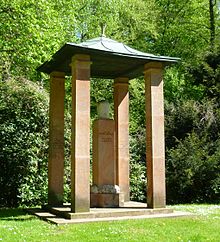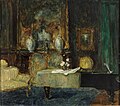Carl Albrecht (painter)
Carl Heinrich Christian Albrecht (born April 2, 1862 in Hamburg , † September 26, 1926 in Königsberg ) was a German painter.
life and work
Albrecht was the second child of Johann Albrecht (1828–?) And Catharina (nee Schardt, 1831–1904). He trained as a businessman, but also attended the general trade school and trained as a drawing teacher from 1882 to 1884. There he met Ludwig Dettmann (1865–1944), who in 1901 became director of the Königsberg Art Academy , with whom he had a lifelong friendship.
Albrecht's goal was to become a landscape painter and for his studies he chose the Grand Ducal Art School in Weimar , which, when Albrecht came to Weimar in 1884, enjoyed the reputation of a modern and progressive teaching facility. There he became a student of the landscape painter Theodor Hagen (1842-1919). Under his influence and that of the artistic environment of the school ("Weimarer Malerschule") and the French painters of the "paysage intime", which were exhibited in Weimar, Albrecht's painting developed from an idealistic to a more realistic and unspectacular image.
In 1889 Albrecht settled in Hamburg as a freelance artist and was a member of the Hamburg Artists' Association from 1832 . The purchase of the small-format picture “Dorfstrasse”, dated 1890, by the Pinakothek in Munich was a first great success for Albrecht. Since 1888 he has participated regularly in the international art exhibitions in the Glaspalast in Munich and since 1891 in the great art exhibitions in Berlin. In addition to these exhibitions, Albrecht showed his works a. a. in art associations in Hamburg, Bremen and Königsberg, as well as in art salons or galleries in various cities in Germany, after 1900 also in the Kunsthaus in Vienna. In 1900 he took part in the World Exhibition in Paris . In 1905 Albrecht was awarded the Small Golden Medal for Painting in Munich. Further awards followed: 1913 Big Golden Medal in Munich, 1914 Big Golden Medal in Berlin.
In 1895 Albrecht went on a study trip to Holland, Belgium, southern Germany and Italy. He processed his impressions of the landscape in several works and he also took up a new theme, still life .

In 1905, at the suggestion of Ludwig Dettmann, the director, Albrecht was appointed to the Königsberg Art Academy , from January 1, 1906 to December 31, 1909, initially as an assistant teacher for head and still life painting, and from January 1, 1910 to March 31, 1925 as a more ordinary teacher Teacher. In 1908 he married Elisabeth Agnes Hochstrasser, who was born in Frankfurt, in Kronberg am Taunus (December 6, 1876 - February 27, 1952). The marriage resulted in two sons: Joachim (1910–1978) and Karl Otto Adolf (1914–1968). The result was a series of pictures showing Lisa as a mother with a child. Through the connection with Lisa Hochstrasser, the Taunus landscape also gained in importance for Albrecht's work, in which he had previously recorded the landscapes of Thuringia, Schleswig-Holstein and northern Germany.
During the Great Berlin Art Exhibition of 1914, Albrecht was able to present a retrospective with 30 works in a separate room. From this, the Berlin National Gallery acquired the painting “The Embroiderer”, which was made before 1911, after it had already bought the first painting “Summer Landscape” in 1905. During these years of the greatest public recognition of Albrecht's art, the first harbingers of his illness appeared, with the result that he was retired on March 31, 1925 due to illness. Carl Albrecht died on September 26, 1926 in Königsberg. He is buried in Hamburg in the Ohlsdorf cemetery . The grave monument was designed by the architect Friedrich Lahrs (1880–1964), a colleague of Albrecht at the Königsberg Art Academy.
Albrecht's work spanned the last decade of the 19th century and around the first quarter of the 20th century. His artistic roots are in 19th century realism. His work was influenced by the new open-air painting , but he also dealt with German impressionism . His image conception and way of working remained deliberately traditional.
In his work he not only limited himself to the genre landscape, but it was also determined by his interest in portraits, still lifes and interiors. Carl Albrecht painted his works in oil on wood, on canvas, on cardboard or on cardboard. Pastels, watercolors, gouaches, etchings and drawings on paper were also created.
Works (selection)
- Dorfstrasse, dated 1890, Munich, Neue Pinakothek Bayerische Staatsgemäldesammlung
- Peat landscape, around 1892, Weimar, Kunstsammlungen Klassik Stiftung Weimar
- Interior, dated 1894, Giessen, Oberhessisches Museum
- Still life (covered table), before 1902, Hamburg, Kunsthalle
- The sculptor, before 1905, Weimar, Kunstsammlungen Klassik Stiftung Weimar
- Old Church in (Bad) Segeberg, before 1906, Munich, Neue Pinakothek Bayerische Staatsgemäldesammlung
- The embroiderer, before 1911, Berlin, Alte Nationalgalerie
- Asparagus still life, before 1914, Oldenburg, State Museum for Art and Cultural History
- The artist's wife - Anna Elisabeth Agnes, dated 1918, Düsseldorf, Kunstmuseum
Photo credits
- ^ River landscape, before 1896, private collection
- ↑ Forest clearing with figures, around 1900, private collection
- ^ A summer day, before 1908, from: Franz Deibel: Carl Albrecht ...
- ↑ Die Embroiderer, before 1911, photo: Alte Nationalgalerie
- ^ Staircase, before 1912, private collection
- ^ Still life (porcelain), before 1914, from: Fritz Stahl: Carl Albrecht ...
- ↑ Interior around 1918, private collection, photo: Volker-H. cutter
literature
- Franz Deibel: Carl Albrecht. In: Westermannsmonthshefte. Volume 113, II, issue 676 (December 1912 to February 1913), pp. 565-576 ( Textarchiv - Internet Archive ).
- Fritz Stahl: Carl Albrecht. In: Velhagen & Klasings new monthly issues. 1914/15, XXIX, Volume 3, pp. 25-33.
- Emil Benezé : Albrecht, Karl . In: Ulrich Thieme , Felix Becker (Hrsg.): General Lexicon of Fine Artists from Antiquity to the Present . Founded by Ulrich Thieme and Felix Becker. tape 1 : Aa – Antonio de Miraguel . Wilhelm Engelmann, Leipzig 1907, p. 233-234 ( Text Archive - Internet Archive ).
- Carl Albrecht. In: General Artist Lexicon. The visual artists of all times and peoples. Volume 2: Alanson - Alvarez. KG Saur, Munich 1992, p. 147.
- Albrecht, Carl. In: Ernst Rump: Lexicon of visual artists in Hamburg, Altona and the surrounding area. Otto Bröcker & Co., Hamburg 1912, p. 2 ( Textarchiv - Internet Archive ).
- Ursula Heinsberg-Hartmann: Carl Albrecht, life and work. Verlag der Kunst, Husum 2014, ISBN 978-3-86530-189-5 . (Biography with catalog of works and exhibitions as well as an extensive appendix with contemporary newspaper articles and documents).
Web links
| personal data | |
|---|---|
| SURNAME | Albrecht, Carl |
| ALTERNATIVE NAMES | Albrecht, Carl Heinrich Christian (full name); Albrecht, Karl; Albrecht, Karl Heinrich Christian |
| BRIEF DESCRIPTION | German painter |
| DATE OF BIRTH | April 2, 1862 |
| PLACE OF BIRTH | Hamburg |
| DATE OF DEATH | September 26, 1926 |
| Place of death | Koenigsberg |








